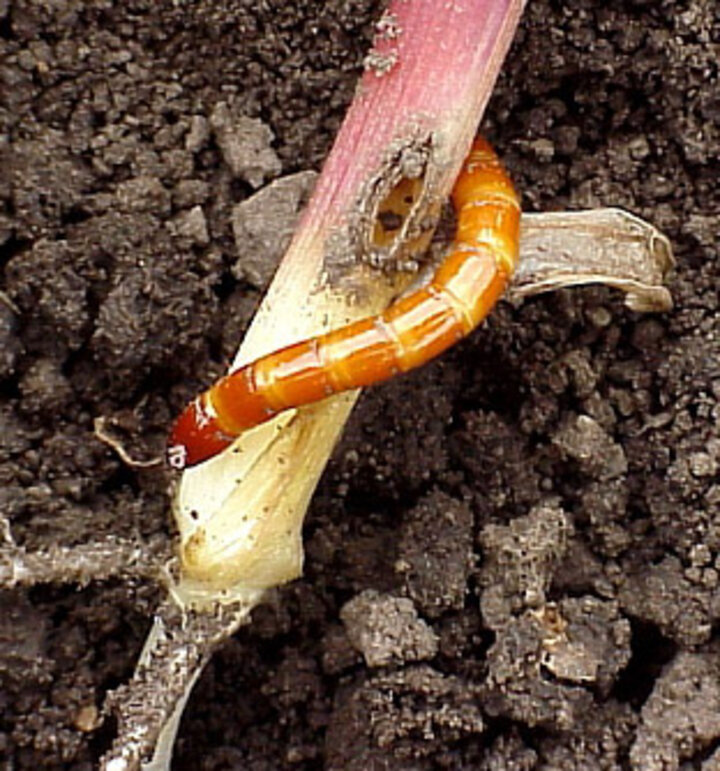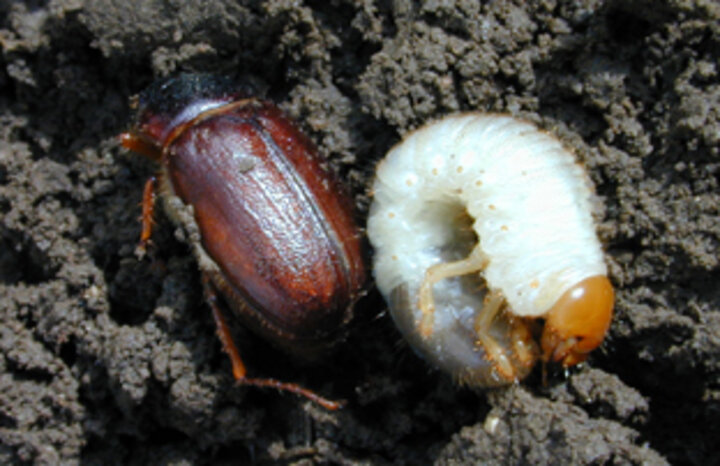Scout Emerging Corn for Insects; Don't Assume Protection
Extension Entomologist Bob Wright discusses scouting seedling corn for insects on the May 15 Market Journal.As corn begins to emerge, be alert to the potential damage that may be caused by early season insects. Most early season insect damage would be caused by cutworms, wireworms, or white grubs.
Wireworms and white grubs are most often associated with fields that have been in pasture or CRP where the grasses were allowed to grow for more than one year. It is rare to see these problems in continuous corn, but exceptions happen. Since wireworms and white grubs feed underground and cutworms feed on or below the soil surface, scout for plant damage and then dig in soil around the plant to identify the insect causing the damage.
Cutworms
Cutworms and other insects may hinder emerging corn plants this spring, even if seed was treated with insecticide or Bt corn hybrids were used. High populations of insects can overwhelm the protection method, regardless of whether it was an insecticide applied at planting (liquid, granular, or seed treatment) or a Bt corn hybrid.



In some cases products are not labeled for the full spectrum of Nebraska insects. For example, Bt corn hybrids expressing the Cry 1F Bt protein list control of black cutworm on the label, but do not list control of other soil cutworm species. The Agrisure hybrids containing both Cry1F and Vip3A Bt proteins list control of black cutworm and dingy cutworm on the label. See the Handy Bt Trait Table for a list of which hybrids express which Bt proteins.
Cutworms can cause serious damage to corn in the first couple weeks after emergence so it is important to scout fields early for damage. Several species of cutworms attack corn. The severity and the area affected will vary greatly, depending on species involved, previous crop history, and weather conditions.
The black cutworm does not overwinter in Nebraska, and infestations depend on moths moving up in southerly spring winds. They are most commonly found in the eastern one-fourth of the state. We have been capturing low numbers of black cutworms in pheromone traps in several counties in Eastern Nebraska. (See trap report. ) Fields with winter annual weeds or abundant crop residue are more attractive to the egg-laying black cutworm moths in the spring. There are several other cutworm species found more widely in Nebraska (dingy, claybacked, army, Sandhills) which overwinter as partly grown caterpillars (Figure 1). Remember that early detection of a problem is essential because most of the cutting occurs within seven days of plant emergence.
Treatment. Generally, a postemergence "rescue" treatment should be considered if cutting is observed on 3-5% or more of plants and the worms are one inch or less in length. Rescue treatments are effective in controlling soil cutworms.
Ambush 2E, Asana XL, Baythroid, Cobalt, Hero, Lorsban 4E, Mustang Max EC, Warrior, Proaxis, Pounce 3.2EC, Stallion, Steed, or other insecticides with similar active ingredients (generics) will give satisfactory control as postemergence sprays. If soil is dry or crusted, rotary hoeing immediately before or after a Lorsban (chlorpyrifos) application may enhance control. The other insecticides are pyrethroids and should not be incorporated.
Wireworms
Wireworms (Figure 2) are the larvae of click beetles. The adult beetles prefer to lay eggs in grass and the larvae can remain in that stage for up to six years, depending on the species. Wireworms are our earliest corn pests each season, as they can feed on the seed before germination, causing reduced plant emergence. Later feeding may kill or stunt small emerged plants.
All wireworm feeding is done underground. Wireworms are white, yellow, orange, or brown with hard shells. They tend to be more numerous in fields that have been in grass or pasture or fields that have had grassy weed problems. Wireworms prefer cooler soil temperatures, under 70°F, so fields that were planted early or have heavy surface residue may be at higher risk than tilled fields.
Treatment. There is no rescue treatment for wireworms, so the main decision at this time is whether there is sufficient stand reduction to warrant replanting. The use of seed treatments like Cruiser and Poncho has greatly reduced the incidence of wireworm damage. They are excellent early season stand protectors.
White Grubs
White grubs (Figure 3) are the larvae of May (or June) beetles. They also prefer to feed on grasses and rarely affect crops other than corn. There are two basic types of grubs.
- Annual grubs complete their development in one year. They do most of their feeding in the late summer and fall and are not considered serious pests of spring planted field crops.
- Three-year grubs, however, can damage corn severely in the last two years of their larval stage. The larvae overwinter deep in the soil. As the soil warms they begin feeding on plant roots. Damage to corn may not occur until the corn is in the 2- to 6-leaf stage. This is difficult because up to the time of feeding, the stand may look fine. Often three-year grub damage is near shelter belts where the adults may congregate to feed and mate.
Treatment. Like wireworms, there is no rescue treatment for white grubs. Again, high risk areas need to be treated at planting. Products for white grub control are similar to wireworm control.
Replanting
If wireworm or white grub damage is serious enough to warrant replanting, use planting time treatments, although the odds for damage diminish with the warming of the soil.
For More Information
- On insecticide products and rates, see the Insect Management section of EC 130, 2015 Guide for Weed Management, with Insecticide and Fungicide Information
- On managing cutworms, see UNL Extension NebGuide G1153, Corn Cutworms
Bob Wright
Extension Entomologist, Lincoln
Keith Jarvi
Extension Educator in Dakota, Dixon, and Thurston Counties
